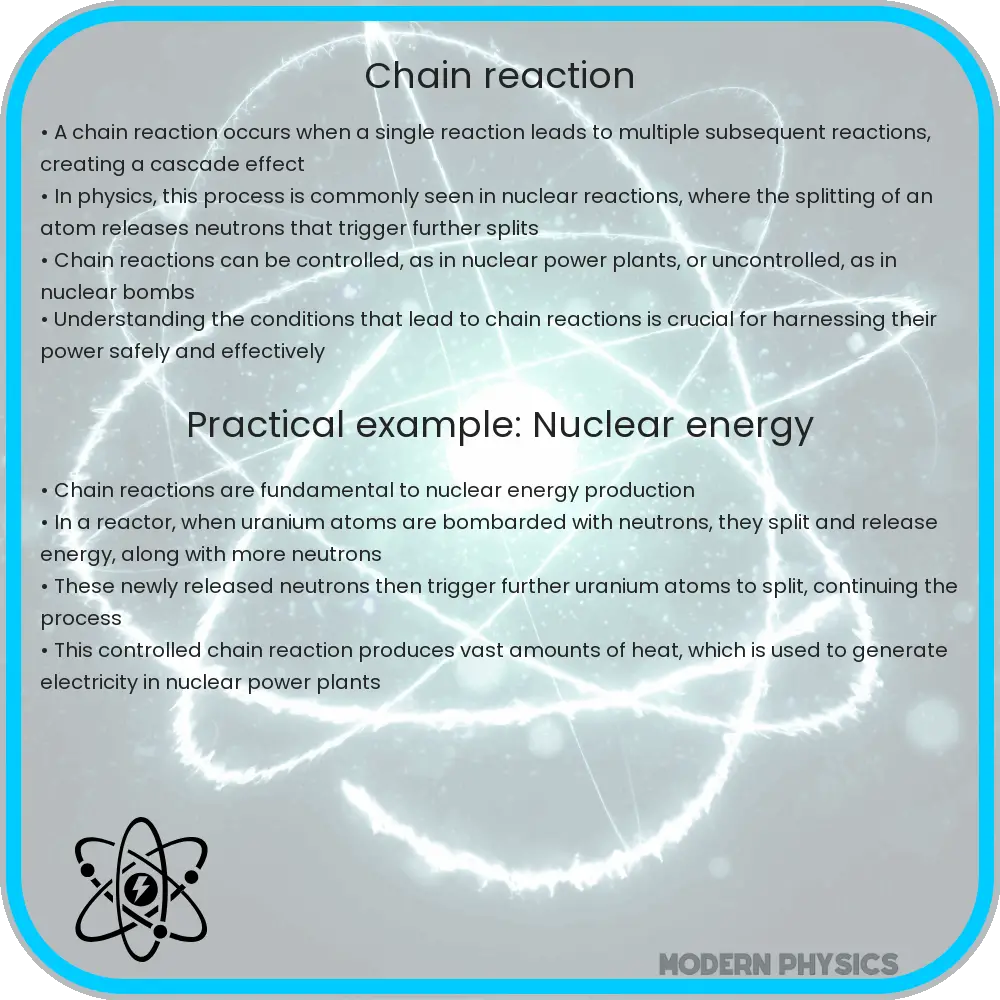Understand chain reactions, a process where initial reactions trigger further reactions, continuing until reactants are exhausted or stabilized, pivotal across chemistry, nuclear physics, and biology.

Introduction to Chain Reactions
A chain reaction is a series of reactions where a reactive product or by-product causes additional reactions to take place. In a chain reaction, the reaction propagates until the reactants are depleted or a stabilizing event occurs. This concept is fundamental in various scientific fields, including chemistry, nuclear physics, and materials science.
Chemical Chain Reactions
In chemistry, a chain reaction involves a sequence of reactions where a reactive intermediate generates further intermediates, which in turn produce more products. A classic example is the polymerization of ethylene to polyethylene. Here, each ethylene molecule reacts with another to form a growing polymer chain until terminated by a catalyst or the depletion of reactants.
- Initiation: Start of the polymer chain.
- Propagation: Rapid growth of the chain.
- Termination: Ending of the chain growth.
Nuclear Chain Reactions
Nuclear chain reactions are processes in which neutrons released from fissions cause further fissions in other nuclear fuel atoms, primarily Uranium-235 or Plutonium-239. This reaction can be controlled (nuclear reactors) or uncontrolled (atomic bombs).
For a sustained nuclear chain reaction:
- A sufficient quantity of a fissile material (critical mass) must be present.
- Neutrons must be moderated to sustain the reaction at a controlled rate in a reactor or uncontrolled rate in an explosive device.
- There must be something to absorb some of the neutrons to control the reaction and ensure it doesn’t explode uncontrollably (in reactors).
The equation describing the number of neutrons in each generation can be expressed as: Nn+1 = k * Nn, where N represents the number of neutrons, n is the generation number, and k is the effective neutron multiplication factor. Based on the value of k, the chain reaction can be:
- k = 1: Steady state (critical).
- k > 1: Increasing rate (supercritical).
- k < 1: Decreasing rate (subcritical).
Biological Chain Reactions
In biology, chain reactions often refer to the series of events where an initial stimulus triggers a cascade of downstream effects. A well-known example includes the signal transduction pathways, such as the activation of proteins in response to a signal molecule binding which amplifies the cellular response.
This process is vital in various biological functions, such as hormone response, neural activity, and the immune response, showing how chain reactions are not limited to just physical or chemical processes but also integral to biological systems.
Another notable example in biology is the polymerase chain reaction (PCR), which is a method used to replicate a specific DNA sequence millions of times. This is fundamental in genetic research, forensic science, and medical diagnostics.
Applications of Chain Reactions
Chain reactions find applications across a broad spectrum of industries and research fields. In the medical field, the polymerase chain reaction (PCR) technique is crucial for detecting diseases, identifying genetic markers, and even in the development of treatments. On an industrial scale, chemical chain reactions are essential for the production of plastics, synthetic rubber, and various other chemicals.
In environmental science, understanding natural chain reactions such as decomposition processes helps in managing waste and pollution. Nuclear chain reactions, on the other hand, are pivotal in generating electricity and in the development of nuclear power as a sustainable energy source, given the global push towards cleaner energy alternatives.
Challenges and Safety Measures
Despite their usefulness, chain reactions pose significant challenges, particularly in terms of control and safety. In nuclear reactors, for example, maintaining the balance at k = 1 to ensure a steady state requires precise control systems and safety protocols to prevent accidents.
Similarly, in chemical manufacturing, controlling the heat and by-products of chain reactions ensures that the processes do not become hazardous. Advanced monitoring systems and emergency shutdown mechanisms are standard in industries where chain reactions are a part of the production process.
Conclusion
Chain reactions, whether they occur in natural or engineered systems, are a fundamental aspect of many processes in science and technology. From the synthesis of large molecules in chemistry to the release of energy in nuclear fissions, these reactions are integral to both advancements and everyday applications. Understanding the basic principles of chain reactions not only enriches our knowledge of science but also enhances our ability to harness these reactions for beneficial purposes.
Carefully managing and optimizing these reactions also underscores the importance of safety and ethical considerations in scientific pursuits. As we continue to explore and manipulate chain reactions, ensuring they are used responsibly and safely will remain a paramount objective. Thus, the study of chain reactions not only offers insights into their manifold applications but also into the broader implications of scientific advancement.
